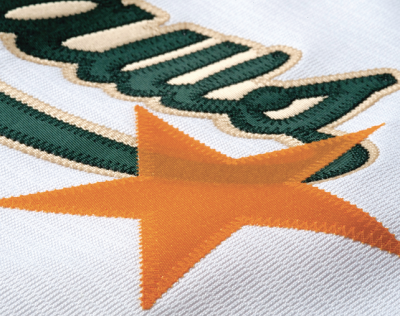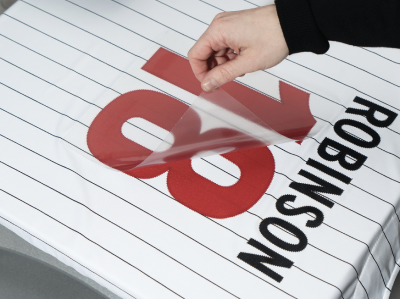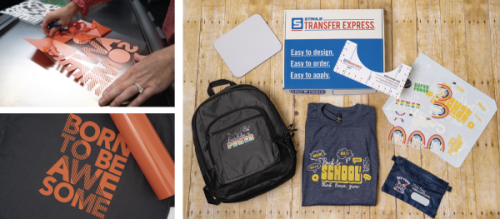Whether you’re looking to add apparel decoration to your personalization and awards business or you’re starting from scratch, you made the right decision. When decorating apparel and accessories, there are a variety of processes, applications and heat transfers to consider. Hopefully, this information will help you narrow down the best process for you—or at least the process you’d like to begin with.
How To Get Started With Heat Transfers
Use this guide to narrow down your best processes.
By: Kelly Walters, affiliate and event coordinator, GroupeSTAHL
(Originally published in the September/October 2022 issue of Insights.)
Whether you’re looking to add apparel decoration to your personalization and awards business or you’re starting from scratch, you made the right decision. When decorating apparel and accessories, there are a variety of processes, applications and heat transfers to consider. Hopefully, this information will help you narrow down the best process for you—or at least the process you’d like to begin with.

One heat press tip: Determine if you'll be creating transfers in-house or outsourcing and applying designs in your workspace.
Before getting started, here are some things to consider:
- Do you have a budget for equipment and materials?
- Who's your customer, or what's your decorating goal?
- Do you currently have orders that need to be fulfilled?
- How big is your production space?
- Are you solo, or do you have employees?
The reason we ask these questions is that the answers can point you down different paths. The most important consideration is whether you're creating transfers in-house or outsourcing and applying designs in your workspace.
Budget and Equipment
No matter your budget, you have to look at what the most important equipment is to produce quality garments. If you are producing your own transfers or outsourcing custom designs, the No. 1 piece of quality equipment you’ll need is a heat press. This gives your business the ability to work efficiently and effectively and provides an accurate reading of time, temperature and pressure, which is the recipe for success.

When reviewing your budget, look at the cost of the press you’re considering, and then determine if you want to add any other equipment:
- Do you want to cut vinyl?
- Do you want to screen print?
- Do you want to produce full-color designs?
Depending on your budget, some of these processes may not be feasible if you’re just getting started, but that doesn’t mean you can’t offer this type of decoration method. So, how do you fulfill these types of jobs?

When reviewing your budget, determine if you'll want any additional equipment.
If you already own laser equipment, you can cut heat transfer products like heat transfer vinyl (HTV) and twill. With HTV, you can check with the company selling the materials to determine if that specific material is safe and compatible with a laser. Believe it or not, most are safe!
Order custom ready-to-apply vinyl transfers (if you aren’t interested in using your laser or in saving money on equipment) or invest in a small craft cutter to cut designs in-house.
Order ready-to-apply screen-printed transfers. This saves you money on screen printing equipment, screen setup and the overall time it takes to clean and prep for the manual screen-printing process.
Full-color transfers can be ordered in a variety of ways—sublimation, direct-to-film (DTF), digital screen print, twill and other textured options. Ordering these eliminates the need for other equipment, which you could add down the road if you prefer.

Some of GroupeSTAHL's heat press work
All the options above are available to be ordered, shipped to your door and ready to be applied. Not only does this save you money, but it gives you time back in your day for other tasks that must be completed as a business owner.
Which Services Should I Offer?
This question plays into knowing who your customer is, as well as needing to fulfill current jobs or opportunities in your pipeline. What does your customer need, and what void are you trying to fill in your business as well as in the market around you? Is your customer price cautious, or is quality always key?
If you want to focus on becoming more of a specialty shop, what transfers can you use that make you stand out: dimensional products such as patches and emblems? Textured transfers to target spirit and fanwear like glitter, metallic and other glitzy materials? Is your goal to get into sports, and are you looking for current jersey trends?
Maybe you’re looking to hit a certain minimum, like one to six pieces, and you need a fast turnaround time. Cutting vinyl in-house on a craft cutter or industrial cutter gives you full control of production time and art capability. If a customer needs an item in 24 hours, it’s your decision whether you can fulfill that request. It’s also the most affordable option to start with if you’re looking to keep production in-house.
Screen-printed transfers allow you to fulfill screen-printed orders while keeping your production space mess-free, maximize order quantities and complete orders in four-to-five business days. These transfers are great for high-detail, quick turnaround times and effortless prep and application. They also give you the ability to maximize what you order by grouping designs on a sheet. Think of these orders as one to two colors but a minimum of 25 pieces.
Vinyl transfers mimic the feel of screen print but allow you to produce your transfers in-house, creating an extremely quick turnaround time of one-to-two business days, given that you have the material. These transfers are great for on-demand personalization and standard designs (no distressing or microcavities in the art unless cut with a laser). Specialty materials are available as well, such as glow-in-the-dark, glitter, reflective and dimensional finishes. With most vinyl, you can create designs with a variety of colors and mix media to create depth and dimension. While there is prep involved with weeding and cutting, you can also order transfers that are delivered to your door, ready to be heat applied.
Direct-to-film transfers provide you the option to decorate in full color with unlimited color options, order individual designs or gang sheets, meet the demand for quick turnaround times and produce extremely fine details. You can also streamline pricing and know the upfront cost to order your designs.
All three of these transfer options offer different price points and produce different prints but feel relatively the same on a garment and fulfill the needs of different customers. No transfer is wrong, so the question becomes: “Which transfer is best for my job, and which is the most cost-effective and gains me a higher profit?”
To help you decide which transfer will be best, ask yourself:
- What is the material of the garment I’m decorating?
- What is the color count of the artwork, and what does it look like?
- What is the quantity of the job?
- When do they need it in hand?
- What is the customer’s budget?
You should be able to look at the specifications of each transfer (adhesive, design capability, production timeframe) and narrow down which will be the best fit. Over time, you might find a transfer or process you really enjoy working with and choose to only offer that as a decoration option. As new transfers and methods are created, you can always adjust your offerings and enhance your production.
Remember, it’s easier to make the decision to add equipment to your lineup once you have more orders in your pipeline and figure out what will make your production life easier. You can decorate apparel with an entire lineup of equipment consisting of a heat press, laser, cutter, print/cut system, sublimation, DTF printer and whatever else comes to market or choose to keep it simple and just rock ’n’ roll with a heat press.
Have fun creating!